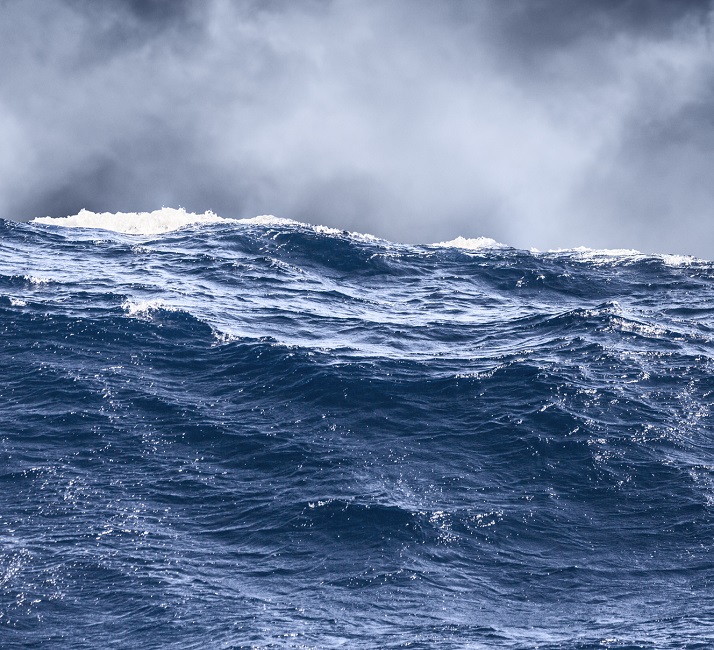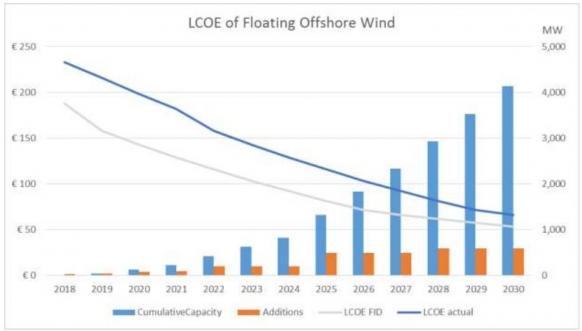Floating wind digital twin set to accelerate wave impact learnings
A new digital twin project led by floating wind developer Principle Power will use advanced wave behavior analysis to improve load calculations critical to long-term design efficiency, project partners told New Energy Update.

Related Articles
Last month, U.S. group Principle Power announced it would lead a consortium of public and private groups to develop the world's first digital twin software for floating offshore wind applications.
Backed by $3.6 million of funding from the U.S. Department of Energy, the 'DIGIFLOAT' project will provide a real-time, high-fidelity numerical model of the 25 MW WindFloat Atlantic (WFA) project currently being installed off the coast of Portugal.
The WFA project consists of three 8 MW MHI Vestas offshore wind turbines, the largest ever used for a floating wind farm, attached to Principle Power's semi-submersible floating wind base.
The digital twin software will be developed in 2020 and validated by Q1 2021. Following a retrofit of a WFA hull in summer 2021, the software will be operational at the facility by Q1 2022.
DIGIFLOAT was among 13 floating wind research projects allocated a total of $28 million under the DOE's Atlantis funding program.
Onshore and offshore wind developers are increasingly turning to digital solutions to improve design and operational efficiency.
Floating wind developers are targeting the deep water offshore wind market, estimated to host 80% of offshore wind resource, equivalent to 4 TW of capacity. Floating wind groups must tackle the additional environmental challenges of open sea areas while also maximizing economies of series and operational savings.
The DIGIFLOAT project will provide a design feedback loop on a real-world project, helping to improve design efficiency and durability of the Principle Power technology, Sam Kanner, R&D Lead at Principle Power and Principal Investigator of the project, told New Energy Update.
"We will install instrumentation in key hotspot areas to measure the structural response of the floating platform. By using these data in our high-fidelity digital twin model, we can generate a real-time estimate of the wear on the structure," Kanner said.
The digital twin will also alert the operator to issues and support preventative maintenance actions to reduce downtimes, he said.
Wave forecasts
A number of ground-breaking U.S. and European digital research projects are aiming to accelerate offshore wind development.
The DOE's latest Atlantis funding round includes several co-control data modelling projects which will test areas such as advanced turbine controls, hull load and flexibility and the operation of large-scale turbines.
In 2018-2019, UK offshore wind research group ORE Catapult led five data pilot projects, covering areas such as machine learning predictions on leading-edge erosion and interactive 3D underwater topography surveys.
Pilot projects have shown that operators must invest in data skills such as machine learning and benchmarking “or risk being left behind in the fourth industrial revolution,” ORE Catapult said in a note in May.
Europe floating wind cost forecast
(Click image to enlarge)
Source: WindEurope's Floating Offshore Wind Energy: a Policy Blueprint for Europe (October 2018)
DIGIFLOAT will use a network of linked offshore buoys developed by University of Washington's Applied Physics Laboratory (APL-UW) to measure and predict a range of incoming wave metrics at the site. The buoys also measure profiles of ocean currents and turbulence.
"The goal of the buoys is to predict, in real-time, the instantaneous wave height at the offshore asset which can lead to more accurate load calculations," Kanner said.
The project partners will reconstruct the ocean wave field, mapping waves as they propagate and evolve towards the floating wind platform, Jim Thomson, Senior Principal Oceanographer at APL-UW, said.
"This is distinct from the more typical statistical approach to wave quantification, which only provides general metrics on the overall wave conditions, i.e. representative values from a collection of random waves," he said.
The buoys will collect wave motion data at 10 Hz, faster than most wave buoys, allowing analysis of a wide range of metrics beyond the typical metrics of height, period, direction and spectra, Thomson said.
"This data will be useful for determining peak hydrodynamic loads, including shocks during wave breaking," he said.
APL-UW has already used this wave field reconstruction process to aid shipping operations in deep waters. In a project for the U.S. Navy, APL-UW used the method to improve operations such as ship to ship transfers in open ocean conditions.
The analysis uses algorithms based on fundamental wave physics and could therefore be applied to any sea areas, Thomson said.
"We are most interested in storms and high sea states, when wave breaking is common and platform loads can become extreme," he said.
Leaner designs
Ahead of wider commercial deployment, floating wind developers are streamlining their designs to reduce manufacturing and installation costs. Developers predict economies of series could see floating wind costs fall below the cost of fixed-bottom projects. Key considerations include materials costs, assembly efficiency and installation speed.
The DIGIFLOAT project will help Principle Power minimize the weight of the design for future wind farms, Kanner said.
"High-fidelity models, validated with real-world data can reduce uncertainty and allow us to reduce safety factors in our design," he said.
The twin will also help to improve turbine stability and increase power output, Kanner said.
"Being able to measure and predict the incoming environmental conditions allows us to pre-ballast the system, enabling the turbine to remain upright, thereby maximizing power production," he said.
Once validated with real-world data, the digital model will also allow Principle Power to test co-control strategies on the turbine and platform, Kanner said. The main control tools include a ballast controller on the hull and nacelle yaw and blade pitch controllers on the turbine.
"Following thorough testing on the digital twin, the optimized control strategies can be uploaded to the onboard SCADA systems to improve the performance of the asset," he said.
Financing costs remain a key challenge at this early stage in floating wind deployment. Principle Power hopes the DIGIFLOAT project will help to lower the cost of financing for future projects, by providing stakeholders with deeper insights into operations.
"The data from the digital twin model can be stored on the cloud and compared to modeled results, giving investors further confidence in the design tools used," Kanner said.
"A de-risked design results in a lower cost of capital," he said.
New Energy Update

